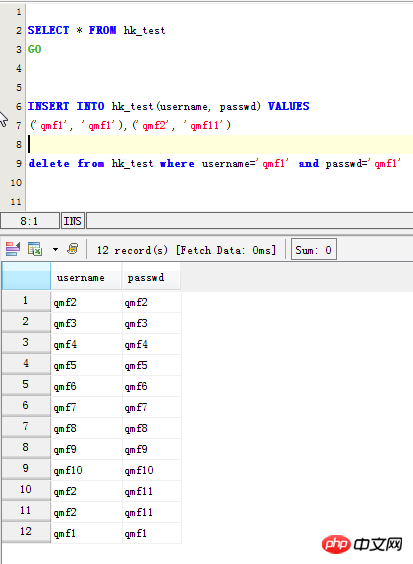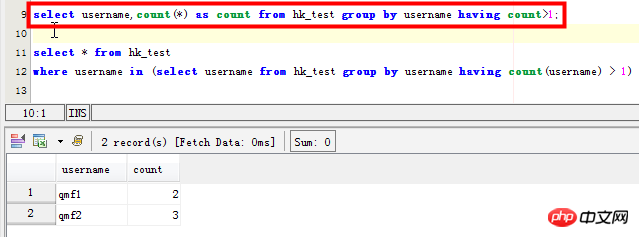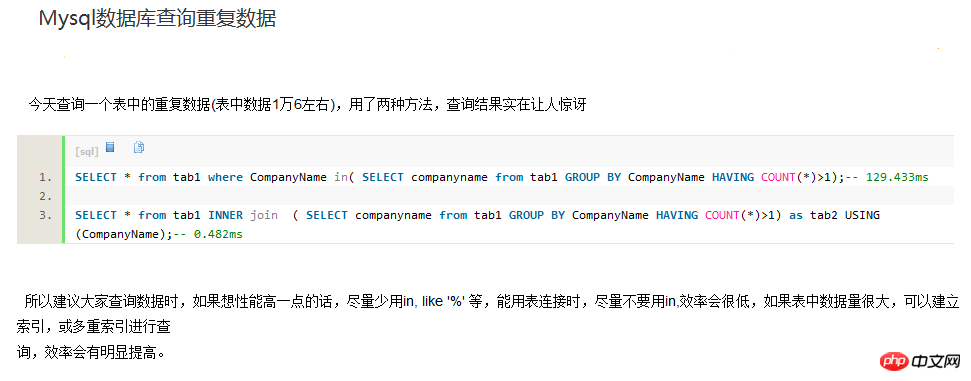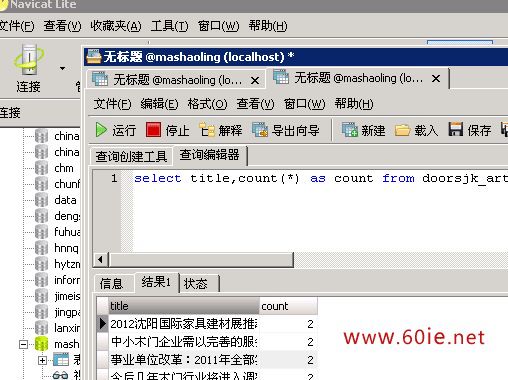 Database
Database
 Mysql Tutorial
Mysql Tutorial
 Detailed introduction to the duplicate data query method in mysql table (picture)
Detailed introduction to the duplicate data query method in mysql table (picture)
Detailed introduction to the duplicate data query method in mysql table (picture)
This article mainly introduces the mysql query method for repeated data in the table. Friends who need it can refer to it
INSERT INTO hk_test(username, passwd) VALUES ('qmf1', 'qmf1'),('qmf2', 'qmf11') delete from hk_test where username='qmf1' and passwd='qmf1'

Duplicate data records in the query table in MySQL:
First check the duplicate original data:

Scenario 1: List the username field with repeated readings Data
select username,count(*) as count from hk_test group by username having count>1; SELECT username,count(username) as count FROM hk_test GROUP BY username HAVING count(username) >1 ORDER BY count DESC;

This method only counts the specific number of duplicates corresponding to the field
Scenario 2: List the specific references for duplicate records in the username field:
select * from hk_test where username in (select username from hk_test group by username having count(username) > 1) SELECT username,passwd FROM hk_test WHERE username in ( SELECT username FROM hk_test GROUP BY username HAVING count(username)>1) 但是这条语句在mysql中效率太差,感觉mysql并没有为子查询生成临时表。在数据量大的时候,耗时很长时间

Solution:
于是使用先建立临时表 create table `tmptable` as ( SELECT `name` FROM `table` GROUP BY `name` HAVING count(`name`) >1 ); 然后使用多表连接查询 SELECT a.`id`, a.`name` FROM `table` a, `tmptable` t WHERE a.`name` = t.`name`; 结果这次结果很快就出来了。 用 distinct去重复 SELECT distinct a.`id`, a.`name` FROM `table` a, `tmptable` t WHERE a.`name` = t.`name`;
Scenario 3 : View records with duplicate fields: For example, username and passwd fields have duplicate records:
select * from hk_test a where (a.username,a.passwd) in (select username,passwd from hk_test group by username,passwd having count(*) > 1)

Scenario 4 : Query records with multiple fields that are repeated at the same time in the query table:
select username,passwd,count(*) from hk_test group by username,passwd having count(*) > 1

MySQL查询表内重复记录 查询及删除重复记录的方法 (一) 1、查找表中多余的重复记录,重复记录是根据单个字段(peopleId)来判断 select * from people where peopleId in (select peopleId from people group by peopleId having count(peopleId)>1) 2、删除表中多余的重复记录,重复记录是根据单个字段(peopleId)来判断,只留有一个记录 delete from people where peopleId in (select peopleId from people group by peopleId having count(peopleId)>1) and min(id) not in (select id from people group by peopleId having count(peopleId)>1) 3、查找表中多余的重复记录(多个字段) select * from vitae a where (a.peopleId,a.seq) in (select peopleId,seq from vitae group by peopleId,seq having count(*)>1) 4、删除表中多余的重复记录(多个字段),只留有rowid最小的记录 delete from vitae a where (a.peopleId,a.seq) in (select peopleId,seq from vitae group by peopleId,seq having count(*) > 1) and rowid not in (select min(rowid) from vitae group by peopleId,seq having count(*)>1) 5、查找表中多余的重复记录(多个字段),不包含rowid最小的记录 select * from vitae a where (a.peopleId,a.seq) in (select peopleId,seq from vitae group by peopleId,seq having count(*) > 1) and rowid not in (select min(rowid) from vitae group by peopleId,seq having count(*)>1) (二) 比方说 在A表中存在一个字段“name”,而且不同记录之间的“name”值有可能会相同,现在就是需要查询出在该表中的各记录之间,“name”值存在重复的项; Select Name,Count(*) From A Group By Name Having Count(*) > 1 如果还查性别也相同大则如下: Select Name,sex,Count(*) From A Group By Name,sex Having Count(*) > 1 (三) 方法一 declare @max integer,@id integer declare cur_rows cursor local for select 主字段,count(*) from 表名 group by 主字段 having count(*) >; 1 open cur_rows fetch cur_rows into @id,@max while @@fetch_status=0 begin select @max = @max -1 set rowcount @max delete from 表名 where 主字段 = @id fetch cur_rows into @id,@max end close cur_rows set rowcount 0

SELECT * from tab1 where CompanyName in( SELECT companyname from tab1 GROUP BY CompanyName HAVING COUNT(*)>1); -- 129.433ms SELECT * from tab1 INNER join ( SELECT companyname from tab1 GROUP BY CompanyName HAVING COUNT(*)>1) as tab2 USING(CompanyName); -- 0.482ms 方法二 有两个意义上的重复记录,一是完全重复的记录,也即所有字段均重复的记录,二是部分关键字段重复的记录,比如Name字段重复,而其他字段不一定重复或都重复可以忽略。 1、对于第一种重复,比较容易解决,使用 select distinct * from tableName 就可以得到无重复记录的结果集。 如果该表需要删除重复的记录(重复记录保留1条),可以按以下方法删除 select distinct * into #Tmp from tableName drop table tableName select * into tableName from #Tmp drop table #Tmp 发生这种重复的原因是表设计不周产生的,增加唯一索引列即可解决。 2、这类重复问题通常要求保留重复记录中的第一条记录,操作方法如下 假设有重复的字段为Name,Address,要求得到这两个字段唯一的结果集 select identity(int,1,1) as autoID, * into #Tmp from tableName select min(autoID) as autoID into #Tmp2 from #Tmp group by Name,autoID select * from #Tmp where autoID in(select autoID from #tmp2) 最后一个select即得到了Name,Address不重复的结果集(但多了一个autoID字段,实际写时可以写在select子句中省去此列) (四)查询重复 select * from tablename where id in ( select id from tablename group by id having count(id) > 1) 常用的语句 1、查找表中多余的重复记录,重复记录是根据单个字段(mail_id)来判断 代码如下 复制代码 SELECT * FROM table WHERE mail_id IN (SELECT mail_id FROM table GROUP BY mail_id HAVING COUNT(mail_id) > 1); 2、删除表中多余的重复记录,重复记录是根据单个字段(mail_id)来判断,只留有rowid最小的记录 代码如下 复制代码 DELETE FROM table WHERE mail_id IN (SELECT mail_id FROM table GROUP BY mail_id HAVING COUNT(mail_id) > 1) AND rowid NOT IN (SELECT MIN(rowid) FROM table GROUP BY mail_id HAVING COUNT(mail_id )>1); 3、查找表中多余的重复记录(多个字段) 代码如下 复制代码 SELECT * FROM table WHERE (mail_id,phone) IN (SELECT mail_id,phone FROM table GROUP BY mail_id,phone HAVING COUNT(*) > 1); 4、删除表中多余的重复记录(多个字段),只留有rowid最小的记录 代码如下 复制代码 DELETE FROM table WHERE (mail_id,phone) IN (SELECT mail_id,phone FROM table GROUP BY mail_id,phone HAVING COU(www.jb51.net)NT(*) > 1) AND rowid NOT IN (SELECT MIN(rowid) FROM table GROUP BY mail_id,phone HAVING COUNT(*)>1); 5、查找表中多余的重复记录(多个字段),不包含rowid最小的记录 代码如下 复制代码 SELECT * FROM table WHERE (a.mail_id,a.phone) IN (SELECT mail_id,phone FROM table GROUP BY mail_id,phone HAVING COUNT(*) > 1) AND rowid NOT IN (SELECT MIN(rowid) FROM table GROUP BY mail_id,phone HAVING COUNT(*)>1); 存储过程 declare @max integer,@id integer declare cur_rows cursor local for select 主字段,count(*) from 表名 group by 主字段 having count(*) >; 1 open cur_rows fetch cur_rows into @id,@max while @@fetch_status=0 begin select @max = @max -1 set rowcount @max delete from 表名 where 主字段 = @id fetch cur_rows into @id,@max end close cur_rows set rowcount 0 (一)单个字段 1、查找表中多余的重复记录,根据(question_title)字段来判断 代码如下 复制代码 select * from questions where question_title in (select question_title from people group by question_title having count(question_title) > 1) 2、删除表中多余的重复记录,根据(question_title)字段来判断,只留有一个记录 代码如下 复制代码 delete from questions where peopleId in (select peopleId from people group by peopleId having count(question_title) > 1) and min(id) not in (select question_id from questions group by question_title having count(question_title)>1) (二)多个字段 删除表中多余的重复记录(多个字段),只留有rowid最小的记录 代码如下 复制代码 DELETE FROM questions WHERE (questions_title,questions_scope) IN (SELECT questions_title,questions_scope FROM que(www.jb51.net)stions GROUP BY questions_title,questions_scope HAVING COUNT(*) > 1) AND question_id NOT IN (SELECT MIN(question_id) FROM questions GROUP BY questions_scope,questions_title HAVING COUNT(*)>1) 用上述语句无法删除,创建了临时表才删的,求各位达人解释一下。 代码如下 复制代码 CREATE TABLE tmp AS SELECT question_id FROM questions WHERE (questions_title,questions_scope) IN (SELECT questions_title,questions_scope FROM questions GROUP BY questions_title,questions_scope HAVING COUNT(*) > 1) AND question_id NOT IN (SELECT MIN(question_id) FROM questions GROUP BY questions_scope,questions_title HAVING COUNT(*)>1); DELETE FROM questions WHERE question_id IN (SELECT question_id FROM tmp); DROP TABLE tmp;
Find duplicate records in the mysql data table
There are more and more data in the mysql database, of course, exclude them There is no duplicate data. When maintaining the data, I suddenly thought of deleting the redundant data and leaving valuable data.
The following sql statement can find all duplicate records in a table.
select user_name,count(*) as count from user_table group by user_name having count>1;
Parameter description:
user_name is the duplicate field to be found.
count is used to determine if it is greater than one, it is a duplicate.
user_table is the name of the table to be found.
group by is used for grouping
having is used for filtering.
Replace the parameters with the corresponding field parameters of your own data table, you can first enter Phpmyadmin Or run it in Navicat to see which data is duplicated, and then delete it in the database. You can also directly put the SQL statement into the page that reads news in the background to read it out, and complete it to query the list of duplicate data. If there are duplicates, can be deleted directly.
The effect is as follows:

Disadvantages: The disadvantage of this method is that when the amount of data in your database is large, the efficiency is very low. I The Navicat test was used. The data volume is not large and the efficiency is very high. Of course, the website also has other SQL statements that repeatedly query data. Draw inferences from one example. Please study carefully and find a query statement suitable for your own website. .
The above is the detailed content of Detailed introduction to the duplicate data query method in mysql table (picture). For more information, please follow other related articles on the PHP Chinese website!

Hot AI Tools

Undresser.AI Undress
AI-powered app for creating realistic nude photos

AI Clothes Remover
Online AI tool for removing clothes from photos.

Undress AI Tool
Undress images for free

Clothoff.io
AI clothes remover

Video Face Swap
Swap faces in any video effortlessly with our completely free AI face swap tool!

Hot Article

Hot Tools

Notepad++7.3.1
Easy-to-use and free code editor

SublimeText3 Chinese version
Chinese version, very easy to use

Zend Studio 13.0.1
Powerful PHP integrated development environment

Dreamweaver CS6
Visual web development tools

SublimeText3 Mac version
God-level code editing software (SublimeText3)

Hot Topics
 1386
1386
 52
52
 MySQL: Simple Concepts for Easy Learning
Apr 10, 2025 am 09:29 AM
MySQL: Simple Concepts for Easy Learning
Apr 10, 2025 am 09:29 AM
MySQL is an open source relational database management system. 1) Create database and tables: Use the CREATEDATABASE and CREATETABLE commands. 2) Basic operations: INSERT, UPDATE, DELETE and SELECT. 3) Advanced operations: JOIN, subquery and transaction processing. 4) Debugging skills: Check syntax, data type and permissions. 5) Optimization suggestions: Use indexes, avoid SELECT* and use transactions.
 How to open phpmyadmin
Apr 10, 2025 pm 10:51 PM
How to open phpmyadmin
Apr 10, 2025 pm 10:51 PM
You can open phpMyAdmin through the following steps: 1. Log in to the website control panel; 2. Find and click the phpMyAdmin icon; 3. Enter MySQL credentials; 4. Click "Login".
 MySQL: An Introduction to the World's Most Popular Database
Apr 12, 2025 am 12:18 AM
MySQL: An Introduction to the World's Most Popular Database
Apr 12, 2025 am 12:18 AM
MySQL is an open source relational database management system, mainly used to store and retrieve data quickly and reliably. Its working principle includes client requests, query resolution, execution of queries and return results. Examples of usage include creating tables, inserting and querying data, and advanced features such as JOIN operations. Common errors involve SQL syntax, data types, and permissions, and optimization suggestions include the use of indexes, optimized queries, and partitioning of tables.
 How to use single threaded redis
Apr 10, 2025 pm 07:12 PM
How to use single threaded redis
Apr 10, 2025 pm 07:12 PM
Redis uses a single threaded architecture to provide high performance, simplicity, and consistency. It utilizes I/O multiplexing, event loops, non-blocking I/O, and shared memory to improve concurrency, but with limitations of concurrency limitations, single point of failure, and unsuitable for write-intensive workloads.
 Why Use MySQL? Benefits and Advantages
Apr 12, 2025 am 12:17 AM
Why Use MySQL? Benefits and Advantages
Apr 12, 2025 am 12:17 AM
MySQL is chosen for its performance, reliability, ease of use, and community support. 1.MySQL provides efficient data storage and retrieval functions, supporting multiple data types and advanced query operations. 2. Adopt client-server architecture and multiple storage engines to support transaction and query optimization. 3. Easy to use, supports a variety of operating systems and programming languages. 4. Have strong community support and provide rich resources and solutions.
 MySQL's Place: Databases and Programming
Apr 13, 2025 am 12:18 AM
MySQL's Place: Databases and Programming
Apr 13, 2025 am 12:18 AM
MySQL's position in databases and programming is very important. It is an open source relational database management system that is widely used in various application scenarios. 1) MySQL provides efficient data storage, organization and retrieval functions, supporting Web, mobile and enterprise-level systems. 2) It uses a client-server architecture, supports multiple storage engines and index optimization. 3) Basic usages include creating tables and inserting data, and advanced usages involve multi-table JOINs and complex queries. 4) Frequently asked questions such as SQL syntax errors and performance issues can be debugged through the EXPLAIN command and slow query log. 5) Performance optimization methods include rational use of indexes, optimized query and use of caches. Best practices include using transactions and PreparedStatemen
 MySQL and SQL: Essential Skills for Developers
Apr 10, 2025 am 09:30 AM
MySQL and SQL: Essential Skills for Developers
Apr 10, 2025 am 09:30 AM
MySQL and SQL are essential skills for developers. 1.MySQL is an open source relational database management system, and SQL is the standard language used to manage and operate databases. 2.MySQL supports multiple storage engines through efficient data storage and retrieval functions, and SQL completes complex data operations through simple statements. 3. Examples of usage include basic queries and advanced queries, such as filtering and sorting by condition. 4. Common errors include syntax errors and performance issues, which can be optimized by checking SQL statements and using EXPLAIN commands. 5. Performance optimization techniques include using indexes, avoiding full table scanning, optimizing JOIN operations and improving code readability.
 Monitor Redis Droplet with Redis Exporter Service
Apr 10, 2025 pm 01:36 PM
Monitor Redis Droplet with Redis Exporter Service
Apr 10, 2025 pm 01:36 PM
Effective monitoring of Redis databases is critical to maintaining optimal performance, identifying potential bottlenecks, and ensuring overall system reliability. Redis Exporter Service is a powerful utility designed to monitor Redis databases using Prometheus. This tutorial will guide you through the complete setup and configuration of Redis Exporter Service, ensuring you seamlessly build monitoring solutions. By studying this tutorial, you will achieve fully operational monitoring settings



